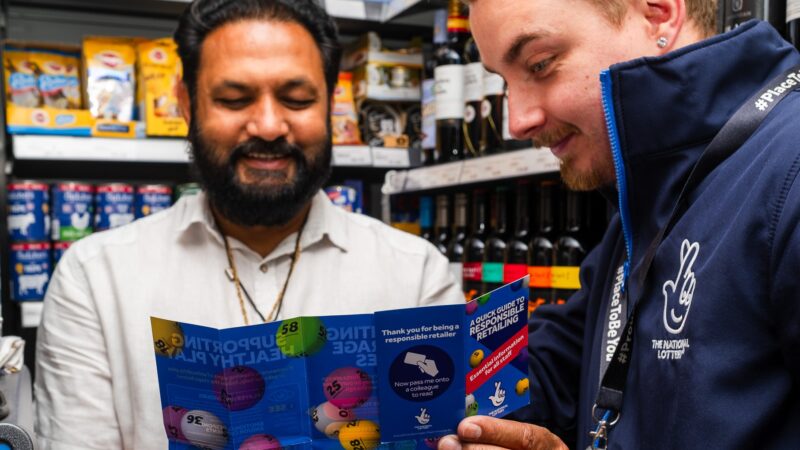Timoney Pharmacy: vaccinations, winter ailments and a robotic future

Former Chief Pharmaceutical Officer Dr Mark Timoney had just returned to his roots and embarked on a major refurbishment of the family business in Lambeg when the pandemic struck – and forced him to revamp the premises.
Timoney Pharmacy had served the Lambeg community for almost 70 years after it was started as Woodlands Pharmacy by Dr Timoney’s mother Margaret back in 1954.
“It’s a community pharmacy in the true sense of the word, in that we are located right in the heart of the local community.” Dr Timoney explains.
“We’ve been able to sustain the healthcare needs of this community in collaboration with healthcare practitioners due to the close proximity to our patients.
“The pharmacy has changed incredibly over the years although the principles of care haven’t changed in that we provide not only medicines but also healthcare advice in response to patients symptoms and information that supports patient wellbeing and healthy lifestyles.”
Landmark
The biggest landmark in recent years was the major refurbishment of the pharmacy and extension of services, including a larger dispensing area and a clinical room which allows for the delivery of healthcare services such as vaccinations, blood pressure monitoring, podiatry services and private consultations.
“My career in pharmacy had previously been on the policy and planning side and this was a unique opportunity to take on the family business and begin to reinvent it in line with the Department of Health’s objectives. We took the opportunity to totally refit the pharmacy facilities and had just managed to complete that work as the pandemic began. This meant that we were well prepared for the change in healthcare delivery brought about by the first surge.”
As other healthcare settings were forced to limit face-to-face contact there was a sudden and increased reliance on pharmacy services. New workflow systems and revamped premises allowed the pharmacy to efficiently maintain an uninterrupted service to the public six days per week.
“We expanded the storage area for dispensing prescriptions and recruited additional staff – for example our Saturday team were incorporated into our regular working team and availed of pharmacy students who weren’t able to attend lectures but wanted to maintain their training and development,” Dr Timoney says.
“We were also able to engage with the local community and voluntary groups in order to recruit volunteers who delivered medicines to all patients who couldn’t leave home during the first lockdown, ensuring that they continued to have their healthcare needs met.
“While some services were stopped during the early days of lockdown, the pharmacy put measures in place to protect staff and customers, including a strict cleaning regime, PPE, barriers and social distancing measures.”
Surge in activity
Demand was boosted by patients being redirected from other healthcare settings and that surge in activity has continued to grow even after the loosening of restrictions.
“Patient contact is a little easier now with the barriers dismantled and the opportunity to use facilities in a more face to face way, and we’ve found that interest in our services has been maintained at the levels that we saw after the advent of the pandemic,” Dr Timoney says.
“With a range of new services – notably Covid – 19 and influenza vaccinations – we’re seeing patient satisfaction with the facilities and services. We’re very interested in their experience and are keen to deliver future services that meet their needs.
“We would like to enhance our ability to supply antibiotics, deliver an increased range of medicines, expand our vaccination service and provide advice on a greater range of symptoms which are commonly encountered such as winter ailments.
“We’d also like to see services that help those patients who struggle with managing large numbers of medicines. And I’d like to see more automation. There are a number of robotic systems that can ease the dispensing process – they effectively read and label the prescription and dispense it under the supervision of the pharmacist. Most hospital pharmacies and the larger dispensing pharmacies have these and I’d be very interested in embedding those arrangements here.”
Vaccination clinics
With pharmacies taking on many of the booster vaccinations, life is busy at the Timoney Pharmacy.
“We currently run clinics for both Covid-19 and flu, at least three per week. It’s taking up a sizable amount of time and resources but there appears to be huge support by the public for vaccination services from pharmacies, “ Dr Timoney says.
“The individual patient facing approach tends to be a little bit more personal so we have no shortage of queries about the vaccines and related issues.”
While there have been worries about how Brexit and the Protocol will impact medical supply chains, Dr Timoney says they aren’t seeing huge issues at the moment.
“We attribute that to the fact that the Department of Health anticipated difficulties and has been managing those for the time being. However, on any day of the week there may be a handful of medications that will be problematic in terms of access, but there has been no significant difference as a result of the Protocol and we work well with our suppliers to manage any shortfalls,” he says.
“We need to be very clear, for now that there are no concerns and the public should be confident that access to medicines has been secured and they will be available when they need them.”
Pharmacy team
The pharmacy team is responsible for two main areas – the front facing team who hand out prescriptions, triage patients and deal with queries and the staff in the dispensing area who compile the prescriptions.
Gazing into his crystal ball, Dr Timoney points out how the pandemic has changed how healthcare services will continue to be delivered.
“I think the public will benefit increasingly in the next number of years from a range of additional services from pharmacies that have been tested during the pandemic period and have been shown to work extremely well in providing beneficial healthcare outcomes,” he says.
“On the strength of that evidence, expect to see further services available to the population in the near future.”
To read the full article, visit Neighbourhood Retailer magazine.







